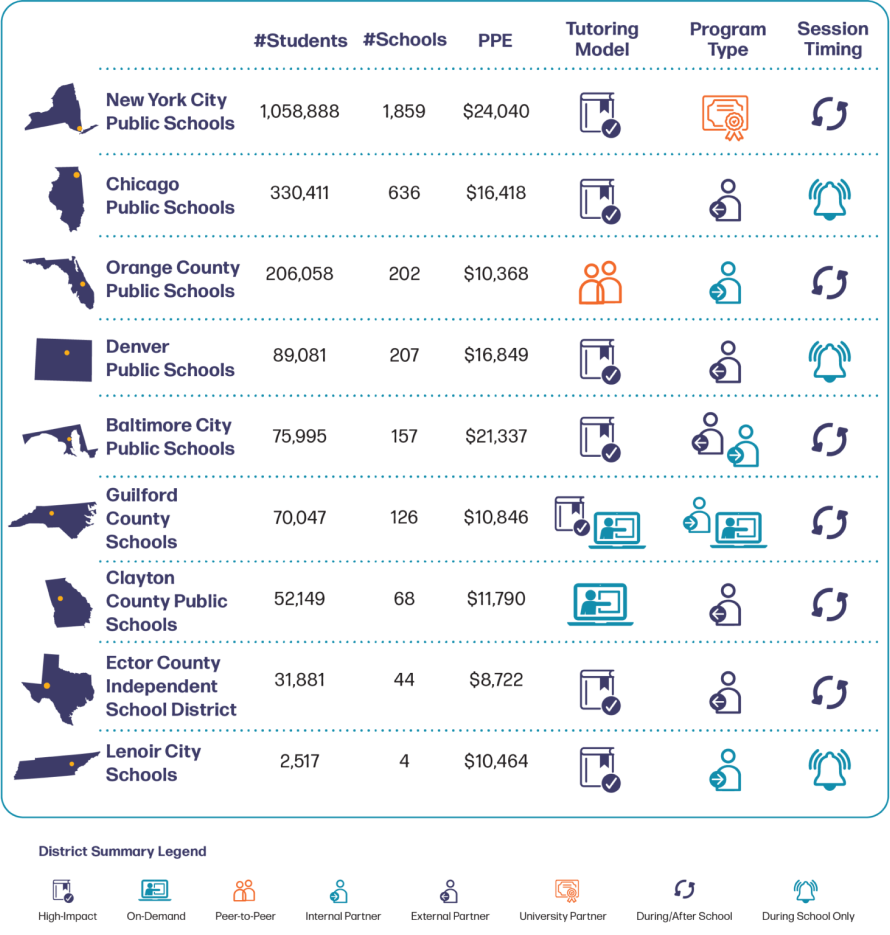Leading for Action: An Insight Report on K-12 Tutoring Programs
School districts across the country are implementing high-impact tutoring as a recovery strategy for pandemic-disrupted learning. This report highlights districts that have established successful K-12 tutoring programs. Learn about deploying tutoring to get meaningful, sustainable student progress.
Get the full report
The Center for Education Market Dynamics • June 09, 2023
The COVID-19 pandemic disrupted education for millions of students.
Across the country, school districts are now implementing high-impact tutoring as a recovery strategy; over $700 million of state Elementary and Secondary School Emergency Relief (ESSER) funds have been invested in tutoring. In a national survey of 1,200 school leaders, almost half reported adopting one-on-one or small group tutoring during the 2020-21 school year.
Many districts launched tutoring programs mid-pandemic, with a focus on a key subset of students, and are now expanding these programs to support learning acceleration more broadly.
Today, three years after the initial wave of nationwide school closures, education leaders are strengthening tutoring programs to align with long-term strategic goals, and shifting from reactive to proactive tutoring program design.
This report highlights districts across the country that established successful K-12 tutoring programs. Drawing on nine case studies that CEMD developed with district leaders, the report offers a deeper look into the real-life challenges and wins of implementation.

The cases do not spotlight the “best” tutoring programs through a typical outcomes-based lens, but instead seek to illuminate core lessons learned by people on the ground, for the benefit of others in their shoes. The cases highlight early insights on process and structure, strategies that worked, and key lessons learned across a variety of program types.
The first section of the report discusses key considerations and decision points that district leaders faced when launching a tutoring program, including:
- Which students and/or schools to prioritize for tutoring services
- Whether to launch an internal tutoring program or contract with an external vendor, and
- How to leverage different methods of program delivery to maximize impact.
The second section focuses on implementation and iterative improvement. Pandemic-related learning loss prompted the launch of many new tutoring programs – but it was a focus on incremental, iterative improvement that drove success over time.
With this lens, the report discusses key enablers of district cultures of continual improvement, including:
- Building buy-in with teachers, students, and the community
- Dedicating support to on-the-ground program rollout
- Developing and prioritizing meaningful, collaborative relationships
- Scheduling tutoring sessions purposefully to maximize student attendance and engagement, and
- Leveraging evaluation to gather feedback and monitor progress.
As educators look at this work, this is mission work for me, and I don’t see myself learning great things and hoarding it from others because they’re all our kids, no matter where they live. And if something is working for us, we should be willing to share with others and let them try it. It may or may not work for them, but if you find something that you think is impactful and working for kids, it is your obligation, I believe, to share that…letting our light shine wherever we can.
Angelin Thompson Director of Extended Academic Learning,
Denver Public Schools
District leaders’ decision-making powerfully impacts student outcomes. But actionable information to guide decision-making is not always available, and as a result, the best learning solutions often don’t reach the students who need them most. With this report, CEMD seeks to provide support for education leaders in states, districts, school boards, and communities to:
Engage in conversations about implementing high-impact tutoring. This report can guide discussions as leaders advocate for and/or evaluate tutoring programs in their own states and districts.
Support strategic decision-making. The comparative nature of this compendium enables leaders to identify and learn from the tutoring programs that are most relevant to them.
Elevate timing, transition, and sustainability considerations. As ESSER spending deadlines loom, the outcomes of current tutoring programs can help inform decisions about tutoring in the future.
Above all, CEMD hopes that this report offers leaders a pragmatic blueprint for deploying tutoring to get meaningful, sustainable student progress.
Want to read the full report?
Download the PDF
